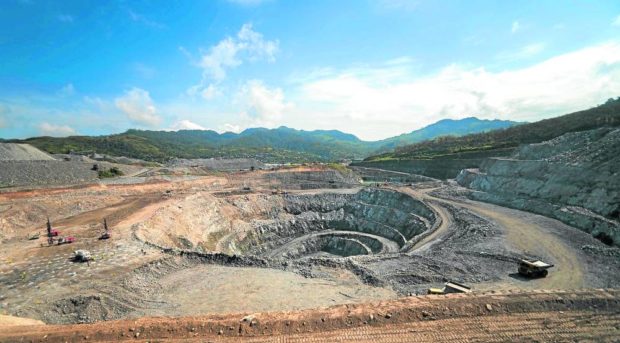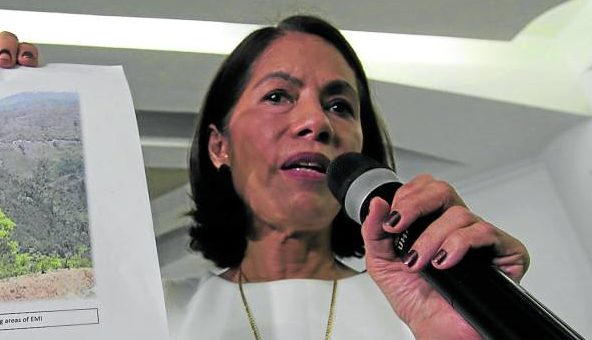
CARVED EARTH: This September 2016 photo shows the massive open pit created by the gold and copper mining operations of the company OceanaGold in Barangay Didipio, Kasibu, Nueva Vizcaya province. (Photo by RICHARD BALONGLONG)`
MANILA, Philippines — With the year about to close, large mining companies got the one thing they were hoping for.
Secretary Roy Cimatu of the Department of Environment and Natural Resources (DENR) signed Department Administrative Order No. 2021-40 on Dec. 23, lifting the four-year-old ban on the open-pit method of mining for copper, gold, silver, and complex ores in the country.
Enforced in 2017, the ban was one of the high-impact measures taken by the late Environment Secretary Gina Lopez, who was known for her green advocacies before she was asked by President Duterte to join his Cabinet.
While the mining industry sees the order as a boost to the sector and the country’s economic recovery, the environmental advocacy group Alyansa Tigil Mina (ATM) calls it “a cruel Christmas gift and a truly ironic act of cowardice and betrayal from Cimatu and (President) Duterte.”
“At this time when climate change brings devastating typhoons such as Odette, lifting the ban on open-pit mining is a shortsighted and misplaced development priority of the government. Once again, the Duterte regime puts more premium to its flawed economic agenda categorizing destructive mining as an ‘essential industry’ as part of the pandemic recovery,” ATM said in a statement on Tuesday.
For job creation
The Chamber of Mines of the Philippines, through group vice president for communications Rocky Dimaculangan, said that as most mining applications had proposed the use of this method, the DENR’s decision would enable the industry to contribute more to the country’s economic recovery particularly from the ongoing pandemic though investment promotion, job creation and poverty alleviation.
The order also signals the possible revival of big-scale mining projects that were put on hold due to the open-pit mining ban. These include Sagittarius Mines Inc.’s $5.9-billion Tampakan copper project in South Cotabato and St. Augustine Gold and Copper Ltd.’s $2-billion King-king copper-gold project in Compostela Valley. Tampakan is said to be Southeast Asia’s largest untapped copper and gold minefield.

Gina Lopez
The DENR said open-pit mining was a “globally accepted method of mining” and “the most feasible option” for mining near-surface or shallow ore deposits.
It has been adopted by thousands of mining companies worldwide and can be operated in a safe manner in adherence to global standards, Dimaculangan said. “It can be rehabilitated in a manner that provides alternative and productive land use after the life of the mine.”
Parameters, conditions
The DENR order covers all mining tenement holders that will adopt surface mining method and sets strict conditions and requirements for those that would use the open-pit method.
The lifting of the ban, according to the DENR order, is meant to “revitalize the mining industry and usher in significant economic benefits to the country by providing raw materials for the construction and development of other industries and by increasing employment opportunities in rural areas.
The order also establishes enhanced parameters and criteria for the types of surface mining methods under the Declaration of Mining Project Feasibility to address the environmental and safety issues involved, according to the DENR.
The order requires mining tenement holders “to conduct baseline information gathering and evaluation and incorporate the same in the mining project feasibility study, and (present) appropriate work programs, which shall be the basis of the [Mines and Geosciences Bureau] in determining whether the proposed mining projects satisfied the requirements.”
Ensure no hazards
Project proponents are required to ensure that their surface mining method would not pose any hazard to public health and safety that might result from ground failure or physical deterioration. They also have to ensure that their mining method will not release any hazardous chemicals into the environment and that they should have “proven and acceptable techniques” to control it through internationally accepted containment, collection and treatment methods.
Proponents of open-pit mining projects, according to the DENR, should have adequate information dissemination plans as part of a comprehensive stakeholders’ involvement process to ensure that all interests and concerns are considered.
They are also required to submit and present programs for surface and subsurface slope-stability monitoring of potential slope failures, as well as programs to mitigate the effects of such incidence, ensure the safety of their personnel and the surrounding communities.

DENR Secretary Roy Cimatu (File photo by NIO JESUS ORBETA / Philippine Daily Inquirer)
Lastly, proponents need to have “sufficient geological data to conduct proper and accurate assessment of local geology, rock mass characteristics, hydrogeology and surface hydrology” in their project areas.
“It is the policy of the state to promote the rational exploration, development, utilization and conservation of mineral resources in the country under the full control and supervision of the state in order to enhance national growth in a way that effectively safeguards the environment and protects the rights of affected communities,” the order reads.
The DENR said there were best-practice control strategies and technologies that could help avoid or manage the negative impacts of open-pit mining.
It also said there were existing laws and policies that banned mining in specific areas, including protected areas, critical watersheds, ancestral lands, and prime agricultural lands.
The new policy will take effect 15 days after its publication.
ATM vowed to continue its opposition to government efforts “to plunder our remaining forests and natural resources.”
“We hope this will be an eye-opener for all environmentalists to be more proactive in engaging in the 2022 elections,” the group said.